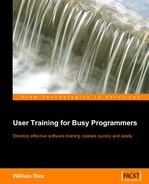You need to create two packages for the course: a Student Guide and an Instructor Guide. The Student Guide is the simplest to create, so let’s start there.
The Student Guide consists of five parts:
- The table of contents
- An introduction
- Printouts of the slides used in the class
- Directions for the in-class exercises
- A listing of resources and contacts for getting help after the class
The following subsections describe each part in detail.
Generate the table of contents after you have assembled the other parts of the Student Guide. If your word processing software gives you the option, also generate a table of graphics when you generate the table of contents. This will make it easier for students to find screenshots when they use the Student Guide for reference.
The introduction will help students ensure that they are the right people to attend the class, that they are prepared for it, and that it will be relevant to them.
At the beginning of the course development process, you established an overall goal for the course. You also established learning objectives for each unit of the course. In the introduction, include a section that states these goals. Consider using a table that lists each unit in the left column and the goals for each unit in the right column.
Who should attend your course? Is it for people with specific job titles? Is the course only for employees, or can contractors and vendors also attend? Are there parts of the course that would be appropriate for the managers or for those who work upstream or downstream of the students? This section of the introduction should answer those questions.
The introduction should list any prerequisite knowledge and skills the student must have before taking the course. This may include:
- Proficiency with the operating environment
- Proficiency with third-party applications used in the class
- An understanding of business processes specific to the students workplace
For example, the students in our fictional course might need to be able to the following:
- Navigate folders and directories in their PCs and on the network
- Use a spreadsheet application to set up basic formulas
- Understand their companys business processes for processing claims
Each prerequisite should be specific enough so that it could be tested, if needed. For example, the prerequisite "Use basic file management functions" cannot be tested; it is too vague. However, the prerequisite "From within the File | Open dialog box, navigate to a network folder and open a file" is specific enough to be tested.
Knowledge and skills are not the only types of prerequisites that you must include. Include any software or hardware that the students must have access. For example, the students might need user IDs and passwords for the application, or they might need to bring their own laptops to the class. List these prerequisites as well.
State the expected duration of the class and the number of students for which it is designed. The information helps your students to fit the class into their schedules.
The student guide should contain printouts of the slides used in the class. Each unit, or chapter, will have its own slide show.
|
Your presentation application may be able to print handouts, with several slides per page and space reserved for taking notes. Check the application’s online help under handouts, and printing. |
Each unit, or chapter, will probably have its own student exercise. Each exercise follows a slide show. Print out each exercise and place it after the appropriate slide show.
The goal of every software class is to enable the students to become independently productive. A list of resources where students can get help with the software supports this goal. The list can include links to online help, where to obtain documentation for the software, and contact information for people who can assist the students.
